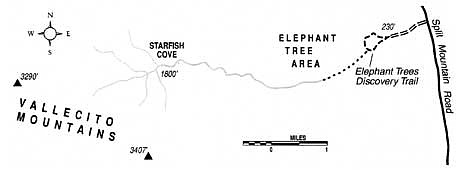 Facebook
Facebook
 X
X
 Instagram
Instagram
 TikTok
TikTok
 Youtube
Youtube
Elephant trees (Bursera microphylla), once considered exceedingly rare in California, have turned out -- after decades of searching and serendipitous discovery -- to be not so rare north of the international border. Still, the scattered "herds" of elephant trees found in Anza-Borrego Desert State Park are worth seeing and appreciating. The park's self-guiding Elephant Trees Discovery Trail (six miles south of Highway 78 and Ocotillo Wells, just off Split Mountain Road) takes you through a small group of these diminutive trees and calls attention to many other plants indigenous to the low, hot, alluvial-fan environment characteristic of this area.
The elephant tree is a very strange botanical beast. With a short, stubby trunk, puffy limbs, reddish twigs and sap, tiny green leaves, and purplish fruit, the plant fits right in with the weird vegetation of Baja's central desert, where it grows in abundance. Like cacti and succulents, the elephant tree is able to store water internally. Native Americans believed the plant was associated with a great power capable of curing many diseases, especially skin ailments.
If you have the physical endurance, navigational skills, and desire to see more plentiful displays of elephant trees, then continue west from the west end of the marked nature trail into any of the many sandy channels of Alma Wash. After about two miles of westward travel up along a rocky alluvial fan, you reach the mouth of a prominent canyon emerging from the Vallecito Mountains. Scattered elephant trees appear as you approach this canyon. Conglomerate rock is exposed at the portals, then big slabs of granitic rock -- the bare bones of the Vallecito Mountains. Inside, elephant trees dot both canyon walls, but more can be found on the north side. Some stand upright ten or more feet tall, while others, rooted to talus slopes, have limbs that seem to slither along in search of some means of support. Once the wiry saplings gain a foothold in small pockets of soil, they survive by rolling with the punches: rock slides merely train the flexible limbs to grow in new directions.
Three miles up the canyon bottom is an area known as Starfish Cove, where several tributary canyons join like the legs of a sea star. Numerous peaks and ridges, all very remote and seldom visited, lie in every direction from there, inviting the attention of motivated rock scramblers.
This article contains information about a publicly owned recreation or wilderness area. Trails and pathways are not necessarily marked. Conditions can change rapidly. Hikers should be properly equipped and have safety and navigational skills. The Reader and Jerry Schad assume no responsibility for any detrimental experience.


Elephant trees (Bursera microphylla), once considered exceedingly rare in California, have turned out -- after decades of searching and serendipitous discovery -- to be not so rare north of the international border. Still, the scattered "herds" of elephant trees found in Anza-Borrego Desert State Park are worth seeing and appreciating. The park's self-guiding Elephant Trees Discovery Trail (six miles south of Highway 78 and Ocotillo Wells, just off Split Mountain Road) takes you through a small group of these diminutive trees and calls attention to many other plants indigenous to the low, hot, alluvial-fan environment characteristic of this area.
The elephant tree is a very strange botanical beast. With a short, stubby trunk, puffy limbs, reddish twigs and sap, tiny green leaves, and purplish fruit, the plant fits right in with the weird vegetation of Baja's central desert, where it grows in abundance. Like cacti and succulents, the elephant tree is able to store water internally. Native Americans believed the plant was associated with a great power capable of curing many diseases, especially skin ailments.
If you have the physical endurance, navigational skills, and desire to see more plentiful displays of elephant trees, then continue west from the west end of the marked nature trail into any of the many sandy channels of Alma Wash. After about two miles of westward travel up along a rocky alluvial fan, you reach the mouth of a prominent canyon emerging from the Vallecito Mountains. Scattered elephant trees appear as you approach this canyon. Conglomerate rock is exposed at the portals, then big slabs of granitic rock -- the bare bones of the Vallecito Mountains. Inside, elephant trees dot both canyon walls, but more can be found on the north side. Some stand upright ten or more feet tall, while others, rooted to talus slopes, have limbs that seem to slither along in search of some means of support. Once the wiry saplings gain a foothold in small pockets of soil, they survive by rolling with the punches: rock slides merely train the flexible limbs to grow in new directions.
Three miles up the canyon bottom is an area known as Starfish Cove, where several tributary canyons join like the legs of a sea star. Numerous peaks and ridges, all very remote and seldom visited, lie in every direction from there, inviting the attention of motivated rock scramblers.
This article contains information about a publicly owned recreation or wilderness area. Trails and pathways are not necessarily marked. Conditions can change rapidly. Hikers should be properly equipped and have safety and navigational skills. The Reader and Jerry Schad assume no responsibility for any detrimental experience.
